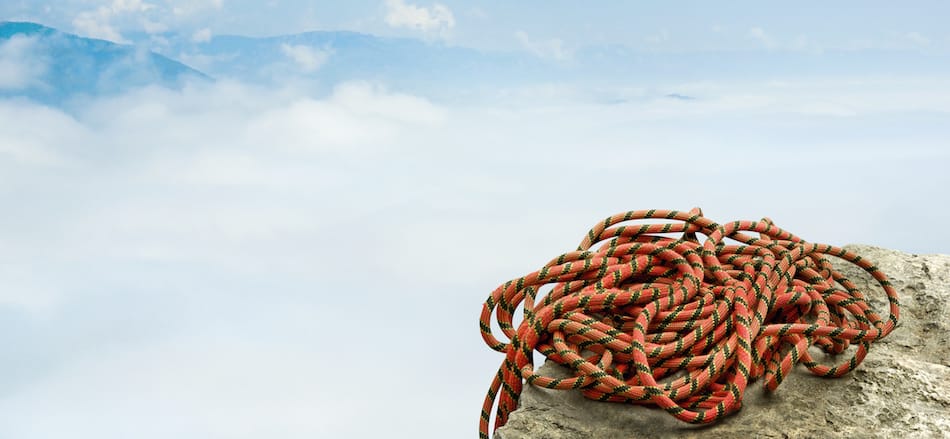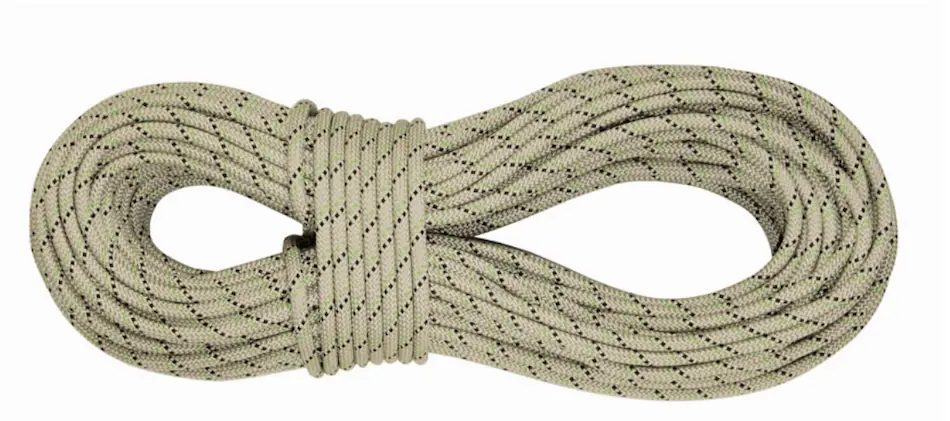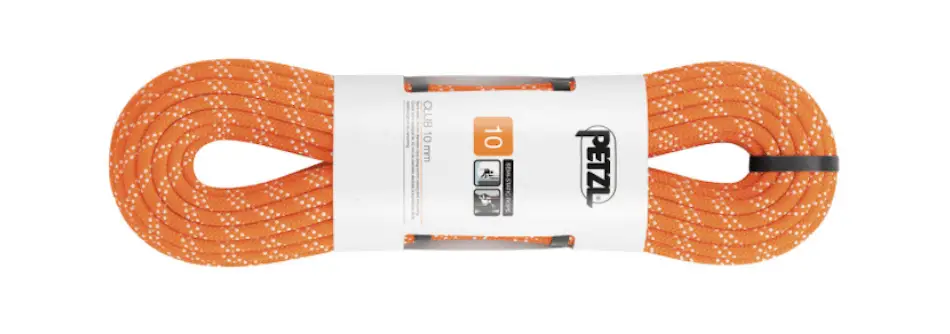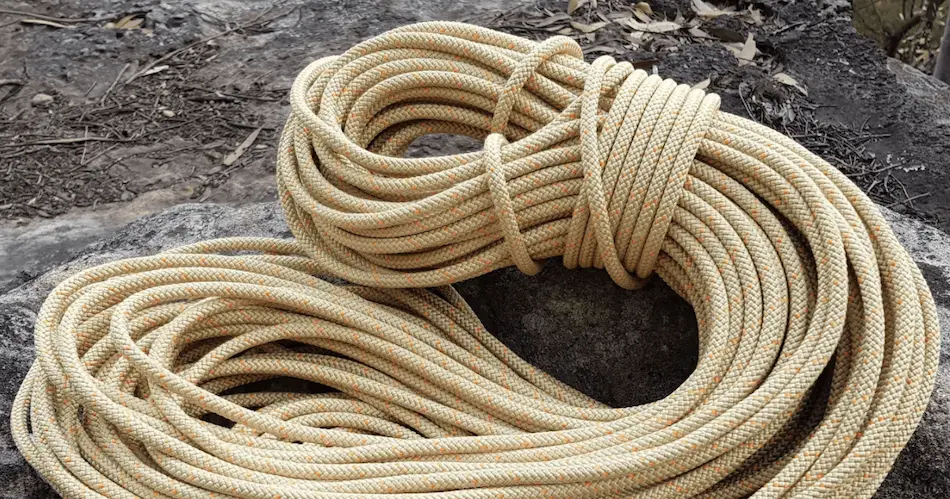
If you’re going to be trusting your entire life in one piece of equipment, you want to make sure that it’s reliable. I’ve experimented with and researched a wide variety of ropes to find the best one for rappelling.
So, what’s the best rope for rappelling? The best rappelling ropes are:
- Sterling C-IV 9mm Canyon
- Petzl Club Canyoneering Semi-Static 10mm Rope
- BlueWater 8mm Canyon Extreme
- Mammut 9.5mm Infinity Dry
- Black Diamond 6mm Static Line
- Sterling CanyonPrime 8.5mm
When evaluating these ropes, I looked at a variety of factors including size, weight, water resistance, tensile strength, and price. Ideally for a rappelling rope you want something that’s light enough to carry around, wide enough to be safe (and compatible with most belay devices), and able to withstand exposure to water.
The other thing I looked at was static vs dynamic ropes, which is a fairly common debate when it comes to picking the best rappelling ropes. For activities that are strictly rappelling based, static ropes are better; they’re more affordable and easier to control the rappel. When sorting through potential candidates, I worked on the assumption that, all other things equal, a static rope would perform better for rappelling than a dynamic rope with the exact same specs would.
The Winners
Without further ado, here are the top six rappelling ropes:
Sterling C-IV 9mm Canyon: Made by American specialty manufacturer Sterling ropes, this state-of-the-art rope has everything you could want and nothing you don’t. Dry treatment, abrasion-resistance, and a low-stretch design make it perfect for rappelling.
Petzl Club Canyoneering Semi-Static 10mm: Slightly burlier in design, this is another static line designed specifically for rappelling or hauling gear. It’s got all of the same features as the 9mm canyon, but it’s slightly heavier, and that was enough to knock it out of the top spot.
BlueWater 8mm Canyon Extreme: This rope is a quintessential depiction of the ‘Fuck it, we ball’ lifestyle. It’s just about perfect in every way, but it also costs twice as much as every other rope on this list. It doesn’t perform well enough to justify that insane markup, which disqualified it out from taking first place.
Mammut 9.5mm Infinity Dry: The best rope for people who want to use rappelling as a secondary activity (such as climbers or mountaineers), this dynamic line performs well in just about every category you could want.
Black Diamond 6mm Static Line: For those who are skilled enough to use it, the BD static line is the perfect backup rope for getting out of sticky situations. Light enough to carry with you everywhere you go, it’s just strong enough to support you on the way down.
Sterling CanyonPrime 8.5mm: This rope came very, very close to taking the number 1 spot on this list. It doesn’t quite have the same features as the C-IV does, but at $100 less it’s a shoe in for the most affordable rope on this list.
What to Look for in a Rappel Rope
This is by no means an exhaustive list. There are tens of options out of there that I didn’t have the chance to touch on that will work perfectly fine as rappel ropes. Additionally, designs change over time as companies continue to innovate and find new ways to stay ahead of the competition.
So, before we get into an in-depth examination of these six ropes, let’s talk a little bit more generally about what you want to look for in a rappelling line.
Now, the first thing to mention is the static vs dynamic debate, as I mentioned above. Most climbing ropes are dynamic (meaning they stretch) because this allows them to safely catch a fall, as the stretchiness of the rope decrease the impact of the falling climber. This is an essential feature for anyone who thinks they might fall while roped in.
For rappelling, however, dynamism is an undesirable trait. Stretchy ropes make it harder to control your descent. They also wear faster, cost more, and are worse when exposed to water. Because of that, all of the best rappel ropes are static (meaning they have no stretch in them).
After that, there are other features to look for when choosing your rope. Something like weight might be important if you’re planning on carrying the ropes for long distances. Buying a rope that is abrasion-resistant with lengthen its lifespan, saving you money and decreasing the chance that the rope breaks in the middle of an activity. Water-treated ropes tend to soak up less liquid, meaning that they won’t weigh you down once they’ve got wet.
The final thing to consider is the width of the rope. Most climbing and rappelling ropes are between 9-11mm; this tends to be the perfect middle ground where the rope creates enough friction in your device to slow you down, without getting jammed. Too narrow and the rappel becomes harder to control; too wide and the rope might not fit at all, making it next to impossible for you to get down.
The ideal rappelling rope is static, lightweight, abrasion-and-water-resistant, and somewhere between 9-11mm. How well do the ropes I’ve chosen measure up to this standard? Let’s find out.
Best Overall Rappel Rope: The Sterling C-IV 9mm

Price: $275 per 60 metres
Where to buy: https://sterlingrope.com/store/climb/ropes/canyon-ropes/c-iv
Pros:
- Wide enough to fit into most rappel devices
- Lightweight enough to carry on most missions
- Water and abrasion resistant
Cons:
- Expensive
- Narrower design can lead to more challenging rappels
To be crowned the best overall rappel rope, you need to be perfect at essentially everything. There are so many companies out there making specialized pieces of equipment that, if your rope has any obvious flaws, it’s going to get knocked from the top stop.
Against a field of extremely stiff competition, the Sterling C-IV rose to the top. The reason I chose this rope is that there’s essentially nothing wrong with it. It’s static, meaning that your rappels are going to be easier to control. It’s (in my opinion) the perfect width for a rappel; 9mm is just wide enough to fit into every belay device and give you a reasonable amount of control, while remaining narrow enough to be lightweight and portable. It comes in a variety of sizes, from 30 meters to 200 meters, so you can pick the perfect size for you. It’s water-and-abrasion-resistant.
Finally, it comes from a trusted manufacturer, which scores it major points in this category. Sterling Climbing has been making static ropes for 25 years now, and they’ve built a name for themselves as an innovative and quality-focused company. Their trusted reputation means that you know this rope is going to deliver on all of its promises.
In short, this rope has everything you could want in a rappelling rope and nothing you don’t. It has every single feature that I would say is important for a rappelling line without being ludicrously expensive. That earns it the top spot on this list.
Now that I’ve gushed enough, let’s talk about what this rope doesn’t do as well. First of all, the price point may not be ludicrous, but it’s certainly more expensive than other ropes. $250 is a lot to ask for a static rope, and it can be a major investment if you’re not going to rappel that often. Additionally, the 9mm design can work against it, as the C-IV becomes more difficult to control when rappelling.
All of this is to say that the C-IV likely isn’t the best option for you if you’re buying your first rappel rope or are more of a beginner. If, however, you’re a seasoned canyoner/caver who’s looking for the best option out there, this is the rope for you.
Best of the Rest: The Petzl Club 10mm and The BlueWater 8mm Canyon Extreme
Not everyone can be the best. These ropes were extremely close to cracking the #1 spot, and are still very good purchases if you’re looking for a rappelling line.
Petzl Club Semi-Static 10mm

Price: $170 per 60m
Where to buy: https://www.petzl.com/US/en/Sport/Ropes/CLUB-10-mm#/Buyonline
Pros:
- More affordable than the Sterling C-IV
- Similar features in terms of water and abrasion resistance
- Easier to control rappels
Cons:
- Slightly heavier than the Sterling C-IV
- Fewer options in terms of length
This rope came so, so close to cracking the number one spot on this list. In fact, if I could go back and do it all over again, I might put them both at the top and call it a tie.
The Petzl Club does just about everything right. It offers good performance when rappelling or hauling, it’s water resistant, and it’s easier to control your rappels than the narrow C-IV is. It also comes at a more affordable price point, costing $80 less than the C-IV for the same amount of rope. For beginners or people who are just looking at getting into rappel-heavy activities, the Petzl Club makes a good argument for the number one spot about the C-IV.
Not everyone is a beginner, however, as this rope has a couple of issues with it that held it back from being number one. First, as I said, is the weight. The Petzl Club is only 10% wider than the Sterling C-IV; despite this, it actually weighs about 40% more, which is a petty significant margin. This weight disparity becomes more pronounced when the ropes get wet. On long days hiking through the mountains or fighting your way a canyon, having your rope weigh almost 50% more is going to make your life significantly more difficult.
Secondly, there are fewer options in terms of length. The Petzl Club comes in 40 meter, 60 meter, and 70 meter options. While this is a fairly standard size offering, let’s compare it to the C-IV: 30 m, 45m, 60m, 90m, 200m. So, 40% more weight, 40% fewer options in terms of length.
With that being said, the Club is still a very good option for someone looking to buy a rappelling rope. It’ll perform well in a variety of conditions and last you a long time. In terms of taking the top spot on this list, however, it didn’t quite measure up.
BlueWater 8mm Canyon Extreme

Price: $570 per 60m
Where to Buy: https://www.canyongear.com.au/product/bluewater-8mm-canyon-extreme-rope/
Pros:
- Truly static, with less than 1% stretch factor
- Lightweight and portable
- Sheath-heavy design increases durability
Cons:
- Price
- Might not be compatible with certain belay devices
Before we start: no, that isn’t a typo. Yes, this rope costs almost $10 per foot.
If you want to talk about cutting edge equipment, the BlueWater Canyon blows everything else out of the water. Every inch of this rope is designed for rappelling in the most extreme conditions imaginable, from terrifying canyons in New Zealand to unexplored caves in Northern Spain. From its lightweight design to its slow-stretch features to its enhanced toughness and durability, the BlueWater Canyon is, without a doubt, the best rappelling rope out there in terms of technical specs.
First of all, let’s talk about what this rope does right. First of all, it’s the lightest rope on this list, coming in at 42 grams per meter (almost half of what the Petzl Club weighs). It’s made up of 60% sheath, which extends the lifespan of the rope while also making it stretch less (thus making your rappels easier). It’s dry-treated with water-resistant materials that prevents the rope from soaking up water and allows it to retain its lightweight features. Essentially, every feature you could dream of in a rappelling rope has been packed into an 8mm design.
That being said, there are some flaws with the BlueWater. First of all, it’s narrower than a standard rope. This will make your rappels more difficult to control and may make the rope incompatible with certain rappel devices (like the Petzl Stop Descender).
More importantly, however, is the price point. The BlueWater Canyon is, for lack of a better term, fucking expensive. It costs more than twice as much as the C-IV does and almost three times as much as the Petzl Club. It costs so much that I bet half of my readers did a double take when they saw this price. I’ve been climbing for years and I never even dreamed that someone could charge $570 for a 60m rope (let alone a static one).
More significant than just the price, however, is the fact that the BlueWater Canyon doesn’t justify its insane markup. It’s lightweight, but it’s not actually that lightweight. It weighs 42 grams per meter, which is barely more than the C-IV’s 46 grams per meter despite the fact that the Canyon is 10% smaller. It’s dry-treated and abrasion resistant, but so are a lot of other ropes. The 60% sheath feature is nice, but unless it doubles the lifespan of the rope, it’s just not worth the price.
If you’re pushing the human limit in terms of canyoneering and need the absolute best equipment, the BlueWater Canyon may the rope for you. If that’s not the case, however, you might want to look elsewhere.
Best Rope for Various Activities: The Mammut 9.5mm Infinity Dry

Price: $259 per 60 meters
Where to buy: https://www.mec.ca/en/product/5064-306/9-5mm-Infinity-Dry-Standard-Rope
Pros:
- Lightweight for its diameter
- Smooth feeding and provides comfortable catches
- Durable
Cons:
- Middle marker wears off quickly
- Dynamic, so it’s not ideal for rappelling-specific activity
Sometimes, you want a rope that can do just about everything.
Equipment is expensive, and not everyone has $500 to be dishing out on multiple ropes. If you’re a climber, alpinist, or mountaineer who also happens to enjoy rappelling activities, you might want to purchase an all-around rope than can function in various circumstances. The Mammut 9.5mm Infinity Dry is that rope.
The Infinity Dry is to dynamic ropes what the C-IV is to rappelling lines. It does everything you could want from a rope, no matter what your desired activity is. You’re a climber looking for something to hold you onto the wall while you redpoint your next project? The Infinity Dry gives a soft catch and smooth feeding. You’re an alpinist who needs a lightweight rope for fast-and-high missions in icy conditions? The Infinity Dry will provide that for you. You’re a seasoned trad dad who wants a rope that will last until your kids move out? Buy Mammut.
Seriously, this thing does just about everything you could want for a climbing rope. It’s dry treated, smooth, durable, and lightweight. It’s Outdoor Gear Lab’s editor’s choice for the best overall climbing rope, and those guys know what they’re talking about when it comes to equipment.
Now, with all of that being said, let’s talk about why the Infinity Dry is also good for rappelling. First of all, it comes in a variety of different lengths, so you can pick and choose what you want depending on your requirements. It’s dry-treated, so you can bring it canyoneering or caving without having to worry about it soaking up a bunch of water. It’s lightweight enough to carry to your destination without breaking your back.
Really, the only thing holding this rope back from being one of the top 3 ropes on this list is the fact that it’s a dynamic rope. That makes it harder to perform controlled rappels on, as you’ll have to deal with the line stretching under your weight. However, this dynamism is also what allows the Infinity Dry to work in every other scenario.
As I said, this rope isn’t the best choice if you’re buying something that you only plan to rappel from. If, however, you want a good rope for every activity that you also plan to rappel from, the Mammut Infinity Dry is currently the best tool on the market.
Best Emergency Bail Line: The Black Diamond 6mm Static Accessory Cord

Price: $110 per 60 meters
Where to Buy: https://www.blackdiamondequipment.com/en_CA/6.0-static-rope-BD323105BLAK0651.html
Pros:
- Narrow design makes it ideal to carry as a backup or tagline option
- Flexible and easy to knot
- Minimal elasticity and a good handle
Cons:
- Lower durability
- Nylon sheath soaks up water and increases weight
- Black colouring makes it harder to custom-mark the middle of the rope
Sometimes, things don’t go as planned and you find yourself needing as backup.
For hiking and scrambling missions where you’re pushing the limits, or rock climbing trips where there’s risk that your main line might be compromised, it can be a good idea to bring along a spare rope so that you have a way out if things get too spicy. The Black Diamond Accessory Cord is the perfect rope for the job.
As noted in the title, this rope is only 6mm wide. That makes it 30% narrower than some of the other ropes on this list, and narrower than any stand-alone climbing or rappelling rope you’re ever going to use.
Now, obviously, this width reduction comes with some downside. First and foremost is that this thing is going to be seriously challenging to rappel with. If you’re unprepared, going to pass through your belay device so quickly that you won’t realize what’s going on until you’ve already bottomed out. You need to have the requisite knowledge, experience, and ability to rappel with this thing before you decide to bust it out in the wild. I would also recommend tying a backup and maybe even doubling up on your belay devices to add extra friction.
The narrowness also has some other drawbacks. This rope has limited other purpose; you can either use it as a backup rope or a tagline, and that’s about it. That means that, for the money-conscious climber, this might be too specialized to purchase. Additionally, this rope won’t last as long as other ropes will.
Despite those drawbacks, though, this rope still earns a spot on this list. In terms of working as a backup, nothing else compares to it. First of all, it’s insanely light, coming in at 23 grams per meter. That’s half the weight of the BlueWater rope for 75% the width, meaning you can chuck this thing in your backpack and go all day without really noticing it’s there. It also handles well and is easy to work with, so you’re going to have a smooth rappel and you won’t need to worry about a kinky or stiff rappel.
Additionally, the rope does have some other uses, as it can act as a tagline for your single strand rappels. It’s also pretty affordable, coming in at just over $100. For a piece of gear that could someday save your life, that’s not a half bad price.
As I said above, this rope isn’t for everyone. If you’re pushing the limits with your scrambling trips, though, or you want a backup rope while heading out on an expedition (and something that can also function as a tagline), the BD Accessory cord is the perfect option for you.
Best Bang for your Buck: The Sterling CanyonPrime 8.5mm

Price: $155 per 60 meters
Where to Buy: https://sterlingrope.com/store/climb/ropes/canyon-ropes/canyonprime
Pros:
- Best price-to-functionality ratio of any rope on this list
- Solid abrasion resistance, reasonable weight
- Wide variety of length options
Cons:
- Narrower rope makes it harder to control rappels
- Fewer technical specs than other ropes
The Sterling CanyonPrime is like the younger brother of the C-IV that took top spot on this list. It’s essentially a watered-down version of the same rope that does everything pretty well but might not be ideal for people who are looking to get the absolute most out of their equipment.
This rope is a solid all-arounder that, for first time rappelers or those on a budget, will perform just fine in 90% of the situations you’re going to be using it in. It’s water resistant, so it doesn’t gain a lot of weight when it’s wet. Like all sterling ropes, it’s backed by a quality manufacturing process that ensures a good hand, smooth rappelling, and minimal rope twist. There are a variety of options for your desired length, from 30 meters to 200 meters.
The best thing about the CanyonPrime, however, is its price. It’s cheaper than very other full-sized rope on this list while still bringing along all of the features that you need in a rappelling rope. It might not be the most cutting-edged of the bunch, but it has everything you look for in a good rope.
That being said, there are a few drawbacks. Th CanyonPrime’s width-to-weight ratio is fair atrocious, coming in at 56.4 grams per meter for an 8.5mm rope. That extra weight can really start to wear you down over the course of a day. Additionally, the CanyonPrime is thinner than a standard climbing rope, so not every rappel device out there will be compatible (for example, this rope wouldn’t work with a Petzl Stop Descender). This leads to a bit of a contradiction in its positioning: the rope is aimed at beginners, but I wouldn’t recommend using an 8.5mm rappel rope until you’ve got some experience.
If you know what you’re doing, however, and you’re looking to save some money, the CanyonPrime is the best option out there for giving you solid performability at a pretty reasonable price point. It may not perform quite as well as the other ropes, but for a lot of people out there, it could end up being just what you’re looking for.
Conclusion
There we go! After hours of research, that’s my definitive list of the best rappelling ropes out there.
As always, this list was written for educational purposes only and isn’t specifically advocating that you use any of these ropes. If you chose purchase any of them, do so at your own risk and make sure you know what you’re doing before you attempt to use the rope in a real-life setting.
